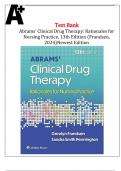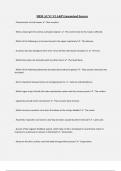Test Bank
Abrams’ Clinical Drug Therapy: Rationales for
Nursing Practice, 13th Edition (Frandsen,
2024)Newest Edition
,Table of Content
SECTION 1 The Conceptual Framework of Pharmacology
Chapter 1 The Foundation of Pharmacology: Quality and
SafetyChapter 2 Basic Concepts and Processes
Chapter 3 Medication Administration and the Nursing Process of Drug Therapy
SECTION 2 Drug Therapy Throughout the Lifespan
Chapter 4 Pharmacology and the Care of Infants and Pediatric Patients Medication Administration
inPediatrics
Chapter 5 Pharmacology and the Care of Adults and Geriatric
Patients Chapter 6 Pharmacology and the Care of Pregnant or
Lactating WomanChapter 7 Pharmacology and Women’s Health
Chapter 8 Pharmacology and Men’s Health
SECTION 3 Drugs Affecting the Hematopoietic and Immune Systems
Chapter 9 Drug Therapy for Coagulation
DisordersChapter 10 Drug Therapy for
Dyslipidemia
Chapter 11 Drug Therapy for Hematopoietic
DisordersChapter 12 Drug Therapy: Immunizations
Chapter 13 Drug Therapy to Decrease Immunity
Chapter 14 Drug Therapy for the Treatment of
Cancer
,SECTION 4 Drugs Affecting Inflammation and Infection
Chapter 15 Inflammation, Infection, and the Use of Antimicrobial
AgentsChapter 16 Drug Therapy to Decrease Pain, Fever, and
Inflammation Chapter 17 Drug Therapy With Corticosteroids
Chapter 18 Drug Therapy With Beta-Lactam Antibacterial Agents
Chapter 19 Drug Therapy With Aminoglycosides and
Fluoroquinolones
Chapter 20 Drug Therapy With Tetracyclines, Sulfonamides, and Urinary
Antiseptics Chapter 21 Drug Therapy With Macrolides and Miscellaneous Anti-
infective Agents Chapter 22 Drug Therapy for Tuberculosis and Mycobacterium
avium Complex DiseaseChapter 23 Drug Therapy for Viral Infections
Chapter 24 Drug Therapy for Fungal
Infections Chapter 25 Drug Therapy for
Parasitic Infections
SECTION 5 Drugs Affecting the Cardiovascular System
Chapter 26 Drug Therapy for
Hypertension Chapter 27 Drug Therapy
for Dysrhythmias
Chapter 28 Drug Therapy for Coronary Heart
Disease Chapter 29 Drug Therapy for Shock and
Hypotension Chapter 30 Drug Therapy for Heart
Failure
SECTION 6 Drugs Affecting the Respiratory System
Chapter 31 Drug Therapy for Nasal Congestion and Cough
,Chapter 32 Drug Therapy to Decrease Histamine Effects and Allergic
ResponseChapter 33 Drug Therapy for Asthma and Bronchoconstriction
,SECTION 7 Drugs Affecting the Renal and Digestive Systems
Chapter 34 Drug Therapy for Fluid Volume Excess
Chapter 35 Nutritional Support Products, Vitamins, and Mineral
SupplementsChapter 36 Drug Therapy for Weight Management
Chapter 37 Drug Therapy for Peptic Ulcer Disease and
HyperacidityChapter 38 Drug Therapy for Nausea and Vomiting
Chapter 39 Drug Therapy for Constipation and Elimination
ProblemsChapter 40 Drug Therapy for Diarrhea
SECTION 8 Drugs Affecting the Endocrine System
Chapter 41 Drug Therapy for Diabetes Mellitus
Chapter 42 Drug Therapy for Hyperthyroidism and Hypothyroidism
Chapter 43 Drug Therapy for Pituitary and Hypothalamic
Dysfunction Chapter 44 Drug Therapy to Regulate Calcium and Bone
Metabolism Chapter 45 Drug Therapy for Addison’s Disease and
Cushing’s Disease
Section 9 Drugs Affecting the Autonomic and Central Nervous System
Chapter 46 Physiology of the Autonomic and Central Nervous Systems and Indications for the Use
ofDrug Therapy
Chapter 47 Drug Therapy for Myasthenia Gravis, Alzheimer’s Disease, and Urinary Retention
Chapter 48 Drug Therapy for Parkinson’s Disease, Urinary Spasticity, and Disorders
RequiringAnticholinergic Drug Therapy
Chapter 49 Drug Therapy With Opioids
Chapter 50 Drug Therapy With Local Anesthetics
,Chapter 51 Drug Therapy With General Anesthetics
Chapter 52 Drug Therapy for Migraines and Other
HeadachesChapter 53 Drug Therapy for Seizure Disorders
and Spasticity Chapter 54 Drug Therapy for Anxiety and
Insomnia
Chapter 55 Drug Therapy for Depression and Mood
StabilizationChapter 56 Drug Therapy for Psychotic
Disorders
Chapter 57 Drug Therapy for Attention Deficit Hyperactivity Disorder and
NarcolepsyChapter 58 Drug Therapy for Substance Abuse Disorders
Section 10 Drugs Affecting the Eye, Ear, and Skin
Chapter 59 Drug Therapy for Disorders of the Eye
Chapter 60 Drug Therapy for Disorders of the Ear
Chapter 61 Drug Therapy for Disorders of the
Skin
, GRADESBOOST.COM
Chapter 1, The Foundation of Pharmacology: Quality and Safety
1. A woman diagnosed with obsessive–compulsive disorder has been
prescribed oralparoxetine hydrochloride. What is the expected effect for this
prescription?
A. Curative effect on symptoms
B. Systemic effect on symptoms
C. Local effect on symptoms
D. Parenteral effect on symptoms
ANS: B
Rationale: Drugs that produce systemic effects are taken into the body, circulated
through the bloodstream to their sites of action in various body tissues, and
eventually eliminated from the body. Curative agents are given to cure a disease
process. In this case, paroxetine hydrochloride will control the symptoms but not cure
the disorder. Drugs with local effects,such as sunscreen and local anesthetics, act
mainly at the site of application. Paroxetine hydrochloride is not administered
G R A D E S B O O S T . C O M
parenterally. Parenteral agents are administered subcutaneously, intramuscularly, or
intravenously.
PTS: 1 REF: p. 3, Introduction OBJ: 1
NAT: Client Needs: Physiological Integrity: Pharmacological and Parenteral
TherapiesTOP: Chapter: 1: The Foundation of Pharmacology: Quality and Safety
KEY: Integrated Process: Nursing Process
BLM: Cognitive Level: Understand NOT: Multiple Choice
2. A client has been prescribed an antibiotic. This medication is a naturally occurring
substance that has been cheGmRicA
alDlyEm
SoBdOifOieSd.TWhaOt M
.C is another name for this type of
medication?
A. Synthetic drug
B. Semisynthetic drug
C. Biotechnology drug
D. Prototype drug
ANS: B
Rationale: Semisynthetic drugs (e.g., many antibiotics) are naturally occurring
substances that have been chemically modified. Synthetic drugs are more standardized
in their chemicalcharacteristics, more consistent in their effects, and less likely to
produce allergic reactions. Biotechnology drugs involve manipulating DNA and RNA
and recombining genes into hybrid molecules that can be inserted into living
organisms. Prototype drugs are the first drug of a particular group to be developed.
PTS: 1 REF: p. 3, Drug Sources OBJ: 1
NAT: Client Needs: Physiological Integrity: Pharmacological and Parenteral
TherapiesTOP: Chapter: 1: The Foundation of Pharmacology: Quality and Safety
KEY: Integrated Process: Nursing Process
BLM: Cognitive Level: Understand NOT: Multiple Choice
3. Which classification applies to morphine?
A. Central nervous system depressant
B. Central nervous system stimulant
GRADESBOOST.COM #1 TEST BANKS WEBSITE





